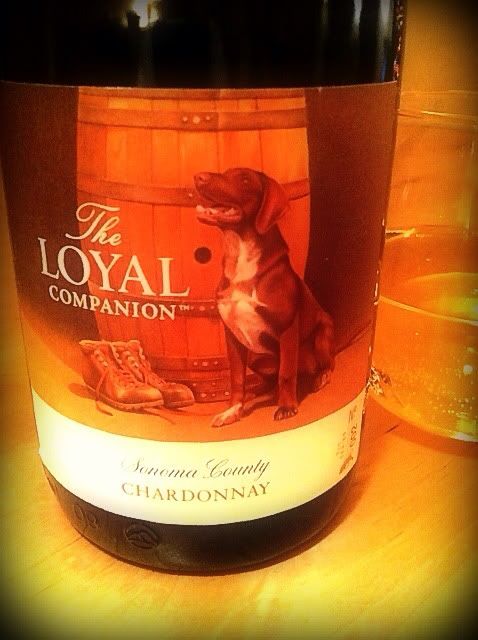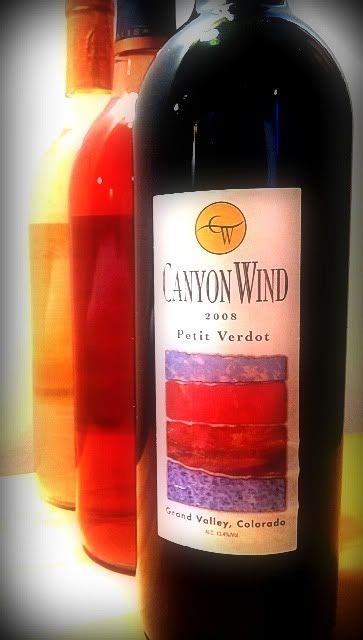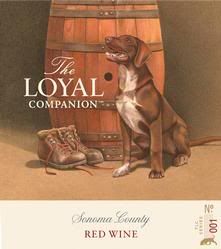Decadent Saint describes themselves as "Colorado’s Craft Winery," and they claim to be pioneering the American craft wine market with a revolution in a bottle. Small batch produced, their 20.5% abv wine concentrates can be diluted to make up to five bottles of a wine and fruit juice mix. Retail is about $20 each, so you’re making sangria for $4 a bottle. The concentrates are made with wine, real fruit and fresh spices, and contain no flavorings. They say they stay fresh for six months after opening without refrigeration.
Enologist and owner Michael Hasler says, "nothing on the shelves compares with them for taste, value or utility."
Decadent Saint was formerly What We Love, The Winery. The concentrates come in three flavors: White Sangria, Fire or Ice Sangria and Mountain Rescue. based on a homemade recipe that Hasler created while he owned a ski lodge in New Zealand.
Decadent Saint White Sangria
This one features "White Wine, Real Fruit, Fresh Spice," as the label says. ."Tastes like freshly blended tropical fruits!" That’s truth in advertising, right there. They promise aromatics of mango, passion fruit, peach, guava, grapefruit and spice, and it's all true. Just add water, although I liked it better with seltzer. Prosecco makes a nice mix, too. The bottle of concentrate makes three to five bottles of white sangria.
It’s really viscous right from the bottle, more so than orange juice, but about the same color. The aroma, undiluted, is like a concentrated orange/tangerine/pineapple juice blend. It tastes like OJ, as well. I did a one-to-one mix with seltzer water and found it was still fairly thick and very much like a mimosa, with a little alcohol at the back end. So, they really do mean it when they say to dilute three to five times.
Decadent Saint Fire Or Ice Sangria
As the name suggests, you can drink it hot or cold, like a sangria or a mulled wine, depending on which holiday you’re celebrating.
Decadent Saint Rocky Mountain Rescue
This concentrate includes red wine, dark chocolate, decaf coffee, berries and spice. Again, there’s no stipulation on temperature. Drink it hot or cold, they say. The Rocky Mountain Rescue leads off with a dark chocolate raspberry note, smoothly transitioning to a rich mocha before giving way to the full spice cacophony.
While sangria is nearly always a limited color in my wine palette, I can say these concentrates make some decidedly good ones. I found that I liked them best with one-to-one or two-to-one dilution, but at that point they are still very viscous and concentrated. Follow the recipe and you'll have enough refreshing sangrias to get through a good part of the summer.
Follow Randy Fuller on Twitter
Showing posts with label Colorado. Show all posts
Showing posts with label Colorado. Show all posts
Monday, June 27, 2016
Thursday, December 15, 2011
CRU VIN DOGS - THE LOYAL COMPANION
For some folks, the wine business has gone to the dogs, and they like it that way. Cru Vin Dogs in a winery based in Denver, Colorado, which "tracks down exceptional vineyards and small lots of wine throughout the world to craft masterful blends of exceptional quality and value."
Every Cru Vin Dogs release features a pencil drawing of a dog - a different breed each time - by gifted artist Jay P. Snellgrove. Prints of these drawings are available to wine club members, with the remainder offered to the public.
The winery also has a philanthropic side showing on their line called “The Loyal Companion.” Proceeds from the sale of these wines helps local animal shelters and rescue groups find homes for some of man’s best friends who are doing without faithful companions of their own.
Cru Vin Dogs’ winemaker Tony Wasowicz makes the Loyal Companion blends with small lots of grapes sourced from vineyards in Sonoma County. I was provided with a couple of samples to try, and here are my notes.
 The Loyal Companion Sonoma County Red Wine hits 14.8% abv on the alcohol scale and the $13 price tag means you can enjoy it even if your finances aren’t running with the big dogs. It’s a mixed breed: 60% Syrah, 25% Cabernet Sauvignon, 10% Malbec and 5% Zinfandel.
The Loyal Companion Sonoma County Red Wine hits 14.8% abv on the alcohol scale and the $13 price tag means you can enjoy it even if your finances aren’t running with the big dogs. It’s a mixed breed: 60% Syrah, 25% Cabernet Sauvignon, 10% Malbec and 5% Zinfandel.
The wine is extremely dark in the glass with a nose of dark fruit - blackberry and black plums - with an earthy overlay of minerals, tobacco and cedar. There’s earthy fruit on the palate too, and plenty of it. Wood spice also figures in on the palate, but not to distraction. Lip smacking acidity and good tannins lead to a nice, dry and rather lengthy finish.
 The Loyal Companion Chardonnay also utilizes grapes from cool climate locations in Sonoma County. It wags its retail at $13 and is barely slimmer in alcohol than the red - 14.5% abv.
The Loyal Companion Chardonnay also utilizes grapes from cool climate locations in Sonoma County. It wags its retail at $13 and is barely slimmer in alcohol than the red - 14.5% abv.
This 100% Chardonnay is a pretty golden color. The nose offers tropical fruit that is almost pungent in its intensity. Oak spices are also present in the aromas. Flavors of pineapple and mango are laced with those oaky spices. The flavor of oak is somewhat heavier than the light touch promised in the winery's notes, so be prepared for some good ol' California Chardonnay. There is a great acidity level, which means pairing with food shouldn't be a problem.
Thursday, July 7, 2011
WINE COUNTRY: COLORADO - CANYON WIND CELLARS
The wine industry in Colorado began in 1890, when then-governor George Crawford planted 60 acres of grapes and other fruit along Rapid Creek, near Palisade. There was modest growth in grape growing and winemaking until you-know-what. Prohibition killed many states' wine industries. In Colorado, the bell tolled early, as the state passed its own Prohibition statute in 1916 - predating the national law by four years. All the grapevines were pulled up at that time in favor of fruit orchards. It wasn't until the late 1960s that grapes and wineries began reappearing in the state.
Norman Christianson was a geologist who made a career of mineral exploration before becoming a vintner. He founded Canyon Wind Cellars in 1991. A family-owned estate winery, Canyon Wind employs Napa winemaker Robert Pepi, who oversees the winemaking work of Jay Christianson.
Canyon Wind Cellars is located in the Grand Valley AVA, in Palisade, Colorado east of Grand Junction north of the Colorado River. The high altitude location offers their grapes hot days and cool nights in which to ripen in the sandstone soil.
The Christiansons are proud of their winery's greenness. In the vineyard, sustainable practices are observed: no herbicides are used and only organic pesticides when needed. A gravity flow system gets the wine to the barrel cellar using no electricity.
 Canyon Wind Wines
Canyon Wind Wines
I received three wines to sample. Two of them are from Canyon Wind's 47-Ten series - a Pinot Grigio/Chardonnay blend and a Merlot rosé - and a Petit Verdot from their varietal line.
47-Ten White 2010
The name of the 47-Ten series refers to the altitude of the vineyards, 4,710 feet. That’s Rocky Mountain high. 60% of the wine is Pinot Grigio from the Cliffside Vineyard while the remaining 40% is Chardonnay from the Riverside Vineyard. At 13.6% abv, this wine does not bring the heat.
The nose shows lovely floral notes and honeydew on a somewhat earthy background. There are melons and peaches on the palate with a shading of yeasty minerality. It’s really quite a delicious white, with a zesty acidity. There’s plenty here to make it useful at the lunch or dinner table.
The mouthfeel is nice and full, and the nose and palate both show a bit of spiciness and vanilla. I was surprised to learn this is an unoaked effort - but the Pinot Grigio was aged sur lie in stainless steel for six months before being blended with the au natural Chardonnay. This explains the rich feel of this wine. (When the dead yeast cells - lees - fall to the bottom of the vat after fermentation, the wine is left in contact with the lees for a time to impart a richness and yeasty flavor.)
Put a chill on the 47-Ten White, and you have a perfect companion on the deck this summer.
47-Ten Rosé 2010
Another from Canyon Wind's 47-Ten line, this rosé is such a deep pink it’s almost red. Made from 100% Merlot, taken completely from Canyon Wind’s Riverside Vineyard, this wine is produced entirely in stainless steel.
The nose comes on like a fruit truck overturned. Fresh, ripe strawberries and cherries abound on the nose and palate, and it’s all fruit - no candy. It’s a wonderfully dry rosé with a nearly astounding level of acidity. I wouldn’t pair it with steak, not because I don’t think it could stand up it, but because I like a red wine with beef. I wouldn’t think twice about having this wine with a grilled pork chop. At 12.3% abv, it doesn’t hit so hard that you have to worry about the second glass.
Petit Verdot 2008
This blend of Petit Verdot and a two-percent splash of Cabernet Sauvignon is sourced entirely from Canyon Wind’s Riverside Vineyard. In the original planting for the vineyard in 1991, it was thought two blocks of Merlot from different nurseries were put in the ground. It turned out that one block was not Merlot, and it wasn’t until eleven years later - with the help of genetic fingerprinting - that the mystery block was determined to be Petit Verdot. A low-intervention vinification leads to 22 months in French and American oak.
Petit Verdot usually plays a supporting role in wines. Indeed, even this grape - during its time in the Twilight Zone - was used for blending. In this wine Petit Verdot gets to sit in the driver's seat and Cabernet Sauvignon has to ride shotgun.
The wine’s color is deep, dark red, but light does get through. On the nose, immediately upon pouring, there is a strong whiff of alcohol. That does not remain for long. In fact, the wine settles down very nicely in short order. The alcohol content is only 13.4% abv, so it was a bit of a surprise to find it so forceful at first. Other elements vie for my attention in much the same way. One whiff is full of amazing fruit - cassis and blueberry, jammy as can be - while another has campfire smoke and creosote on it. It’s like a fireworks show for the nose.
There’s a lovely greenness in the flavor profile and it’s unmistakable even amid all the intense fruit flavors. The wine has a medium-full mouthfeel and a firm tannic structure. It does not lack acidity and shows plenty of the earth in which the grapes were grown. Behind it all is a freshness that makes me think of a mountain stream - an unusual quality in a red wine, at least in my experience.
Our thanks go to Canyon Wind Cellars for contributing these wines and becoming an able representative for Wine Country Colorado.
Follow Randy Fuller on Twitter
Norman Christianson was a geologist who made a career of mineral exploration before becoming a vintner. He founded Canyon Wind Cellars in 1991. A family-owned estate winery, Canyon Wind employs Napa winemaker Robert Pepi, who oversees the winemaking work of Jay Christianson.
Canyon Wind Cellars is located in the Grand Valley AVA, in Palisade, Colorado east of Grand Junction north of the Colorado River. The high altitude location offers their grapes hot days and cool nights in which to ripen in the sandstone soil.
The Christiansons are proud of their winery's greenness. In the vineyard, sustainable practices are observed: no herbicides are used and only organic pesticides when needed. A gravity flow system gets the wine to the barrel cellar using no electricity.
 Canyon Wind Wines
Canyon Wind WinesI received three wines to sample. Two of them are from Canyon Wind's 47-Ten series - a Pinot Grigio/Chardonnay blend and a Merlot rosé - and a Petit Verdot from their varietal line.
47-Ten White 2010
The name of the 47-Ten series refers to the altitude of the vineyards, 4,710 feet. That’s Rocky Mountain high. 60% of the wine is Pinot Grigio from the Cliffside Vineyard while the remaining 40% is Chardonnay from the Riverside Vineyard. At 13.6% abv, this wine does not bring the heat.
The nose shows lovely floral notes and honeydew on a somewhat earthy background. There are melons and peaches on the palate with a shading of yeasty minerality. It’s really quite a delicious white, with a zesty acidity. There’s plenty here to make it useful at the lunch or dinner table.
The mouthfeel is nice and full, and the nose and palate both show a bit of spiciness and vanilla. I was surprised to learn this is an unoaked effort - but the Pinot Grigio was aged sur lie in stainless steel for six months before being blended with the au natural Chardonnay. This explains the rich feel of this wine. (When the dead yeast cells - lees - fall to the bottom of the vat after fermentation, the wine is left in contact with the lees for a time to impart a richness and yeasty flavor.)
Put a chill on the 47-Ten White, and you have a perfect companion on the deck this summer.
47-Ten Rosé 2010
Another from Canyon Wind's 47-Ten line, this rosé is such a deep pink it’s almost red. Made from 100% Merlot, taken completely from Canyon Wind’s Riverside Vineyard, this wine is produced entirely in stainless steel.
The nose comes on like a fruit truck overturned. Fresh, ripe strawberries and cherries abound on the nose and palate, and it’s all fruit - no candy. It’s a wonderfully dry rosé with a nearly astounding level of acidity. I wouldn’t pair it with steak, not because I don’t think it could stand up it, but because I like a red wine with beef. I wouldn’t think twice about having this wine with a grilled pork chop. At 12.3% abv, it doesn’t hit so hard that you have to worry about the second glass.
Petit Verdot 2008
This blend of Petit Verdot and a two-percent splash of Cabernet Sauvignon is sourced entirely from Canyon Wind’s Riverside Vineyard. In the original planting for the vineyard in 1991, it was thought two blocks of Merlot from different nurseries were put in the ground. It turned out that one block was not Merlot, and it wasn’t until eleven years later - with the help of genetic fingerprinting - that the mystery block was determined to be Petit Verdot. A low-intervention vinification leads to 22 months in French and American oak.
Petit Verdot usually plays a supporting role in wines. Indeed, even this grape - during its time in the Twilight Zone - was used for blending. In this wine Petit Verdot gets to sit in the driver's seat and Cabernet Sauvignon has to ride shotgun.
The wine’s color is deep, dark red, but light does get through. On the nose, immediately upon pouring, there is a strong whiff of alcohol. That does not remain for long. In fact, the wine settles down very nicely in short order. The alcohol content is only 13.4% abv, so it was a bit of a surprise to find it so forceful at first. Other elements vie for my attention in much the same way. One whiff is full of amazing fruit - cassis and blueberry, jammy as can be - while another has campfire smoke and creosote on it. It’s like a fireworks show for the nose.
There’s a lovely greenness in the flavor profile and it’s unmistakable even amid all the intense fruit flavors. The wine has a medium-full mouthfeel and a firm tannic structure. It does not lack acidity and shows plenty of the earth in which the grapes were grown. Behind it all is a freshness that makes me think of a mountain stream - an unusual quality in a red wine, at least in my experience.
Our thanks go to Canyon Wind Cellars for contributing these wines and becoming an able representative for Wine Country Colorado.
Follow Randy Fuller on Twitter
Subscribe to:
Comments (Atom)


